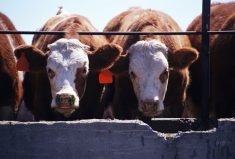Western Canadian feeder cattle prices traded in line with week-ago levels on average, though the market was quite variable across the Prairies.
Favourable temperatures in southern Alberta enhanced demand on all weight categories, especially on grassers from 500 to 650 lbs. Higher-quality backgrounded cattle were also $4-$8 higher in certain cases in Alberta. In Saskatchewan and Manitoba, buyers received limited orders and the market felt extremely sluggish. Shorter-keep replacements were $4-$6 higher at feature sales but cattle under 700 lbs. were down $3-$8. Heifers in the range of 700-900 lbs. were steady to $8 below week-ago levels; however, higher-quality heifers for herd replacement were $8-$12 above the feeder category.
Read Also

U.S. grains: Wheat recovers on short covering, soy continues to fall
Chicago | Reuters – Chicago wheat futures found their footing on Thursday on short covering but remained near eight-week lows…
Larger-frame, lower-flesh controlled weight gain backgrounded steers weighing just over 900 lbs. sold for $198 in southern Alberta. Charolais-cross steers weighing around 850 lbs. sold for $202 in central Alberta. Heifers weighing from 825 to 850 lbs. sold for $189-$195 in the same region. Mixed groups of steers with no special features weighing 500-550 lbs. sold for $280-$285 in southern Manitoba; mixed heifers averaging 525 lbs. were quoted at $225 but similar-weight heifers were about $10 higher across Alberta.
It was difficult to define the market structure this week, which reflects uncertainty for fed cattle prices in the deferred positions. The Alberta fed cattle trade was quoted from $164 to $168 for nearby delivery. Current pen closeout breakeven prices on unhedged cattle are in the range of $198-$205. We’ve experienced a prolonged period of disastrous margins; buyers have a tendency to build in a risk discount on feeders the longer this environment continues.
The March-April timeframe is a period of seasonal strong beef demand, so this may support fed cattle and spillover into the feeder complex. U.S. feeder prices rose $5-$8 higher, in line with the fed cattle market. Wholesale beef prices were stronger this past week, so this is positive in the short term. I mentioned a couple of weeks ago that feedlots were factoring in a stronger currency and the exchange rate has also rallied to three-month highs. Ongoing strength in the Canadian dollar could negate the bounce in beef demand.
— Jerry Klassen is manager of the Canadian office for Swiss-based grain trader GAP SA Grains and Produits. He is also president and founder of Resilient Capital, which specializes in proprietary commodity futures trading and commodity market analysis. Jerry owns farmland in Manitoba and Saskatchewan but grew up on a mixed farm/feedlot operation in southern Alberta, which keeps him close to the grassroots level of grain and cattle production. Jerry is a graduate of the University of Alberta. He can be reached at 204-504-8339.
















